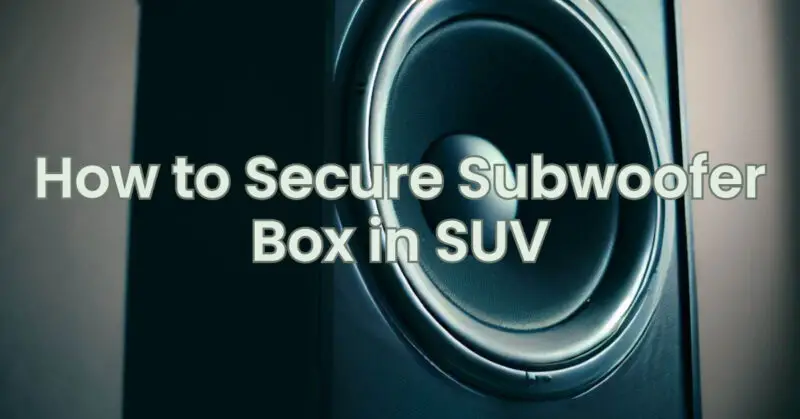Installing a subwoofer box in your SUV can enhance your audio experience during road trips or daily commutes. However, it’s essential to properly secure the subwoofer box to prevent damage, ensure safety, and maintain optimal sound quality. In this article, we will provide you with a step-by-step guide on how to securely install and secure a subwoofer box in your SUV, allowing you to enjoy powerful bass without any worries.
- Select the Right Subwoofer Box: Choose a subwoofer box that is compatible with your SUV’s interior space, dimensions, and power requirements. Consider the size, shape, and design of the box to ensure it fits well within the available cargo area while allowing for proper ventilation and easy access to controls and connections.
- Determine the Placement: Identify the most suitable location in your SUV to install the subwoofer box. The cargo area is often a popular choice as it provides ample space and easy accessibility. However, you may also consider custom enclosure options or utilizing spare tire wells if available. Choose a location that does not obstruct visibility, impede passenger comfort, or interfere with other cargo.
- Prepare the SUV’s Interior: Before installation, thoroughly clean and clear the area where the subwoofer box will be placed. Remove any loose items, debris, or cargo to create a clean and stable surface. This step ensures a secure installation and prevents any potential rattling or interference.
- Securing the Subwoofer Box: There are several methods to secure a subwoofer box in your SUV:
a. Bolting or Screw Mounting: If possible, consider using bolts or screws to secure the subwoofer box to the SUV’s interior. Locate suitable mounting points on the box and the vehicle’s structure, such as floor panels or cargo tie-downs. Ensure a proper fit by drilling pilot holes and using appropriate hardware. This method provides excellent stability and minimizes movement.
b. Strapping or Tie-Downs: Alternatively, you can use heavy-duty straps or tie-downs to secure the subwoofer box. Attach the straps to anchor points in the SUV’s cargo area, such as cargo hooks or D-rings. Ensure the straps are tight and secure, preventing any shifting or sliding during vehicle movement.
c. Custom Mounting Brackets or Enclosures: Depending on your SUV model, there may be custom mounting brackets or enclosure options available. These accessories are designed specifically for secure subwoofer box installation, ensuring a precise fit and optimal stability. Check with the manufacturer or reputable car audio specialists for suitable options.
- Wiring and Connections: After securing the subwoofer box, carefully route and connect the wiring. Ensure all connections are secure and free from any potential damage or interference. Follow the manufacturer’s instructions for wiring, including proper grounding, connecting the subwoofer to the amplifier, and routing power and signal cables.
- Test and Fine-Tune: Once the installation is complete, test the subwoofer system to ensure everything is functioning properly. Listen for any rattling, vibrations, or distortion, which may indicate an insecure installation or incorrect settings. Make necessary adjustments to eliminate any issues and fine-tune the sound to your preferences.
- Maintenance and Safety: Regularly inspect the subwoofer box, mounting hardware, and wiring connections to ensure everything remains secure and in good condition. Check for any signs of wear, loose screws, or changes in sound quality. Additionally, ensure that the subwoofer box installation does not compromise the safety features of your SUV or obstruct airbag deployment zones.
Securing a subwoofer box in your SUV is essential for both optimal audio performance and safety. By following the step-by-step guide provided in this article, you can confidently install and secure a subwoofer box in your SUV, enhancing your listening experience on the road while maintaining a safe and enjoyable driving environment.


